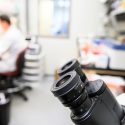Brain-gut connection may reveal way to prevent cocaine addiction
Cocaine disrupts the balance of microbes in the guts of mice, part of a cycle of waxing and waning neurochemicals that can enhance the drug’s effects in the brain. But the same chemicals may also be harnessed to prevent addiction, according to new research from the University of Wisconsin–Madison.
Cocaine increases levels of a hormone called norepinephrine in users’ intestines, triggering an explosion of growth of proteobacteria, a family of microbes that includes the common and sometimes harmful bacterium E. coli.

Vanessa Sperandio
“All this colonizing E. coli needs nitrogen to grow, and their preferred food is glycine, an amino acid that works in the brain as a neurotransmitter,” says Vanessa Sperandio, professor and chair of Medical Microbiology and Immunology in UW–Madison’s School of Medicine and Public Health and co-author of a study published recently in the journal Cell Host & Microbe. “So, an overgrowth of E. coli causes glycine levels to go down around the body, including in a pathway in the brain where glycine manages the response to cocaine.”
The researchers administered cocaine to a group of mice infected with proteobacteria — either a strain of E. coli isolated from humans or a similar kind of bacteria that infects rodents — and found the proteobacteria-carrying mice experienced more cocaine-induced movement and cocaine-seeking behavior than mice without the proteobacteria in their guts.
“With their glycine depleted, they were more responsive to cocaine and more prone to addiction than mice with normal microbiota in the intestine,” Sperandio says.
The researchers then introduced to another group of mice a strain of E. coli lacking genes that allow the bacteria to eat glycine. When those mice encountered cocaine, they were less affected by the drug.
“E. coli were still responding to the norepinephrine and colonizing the mouse gut, but it had to find a food source other than glycine,” Sperandio says. “This shows us it is the glycine depletion affecting the brain. Prevent the glycine depletion, and the mice don’t respond to the cocaine by trying to get more and more.”
It’s an important step toward understanding the biochemistry of cocaine addiction, according to the researchers, and it may present a way to keep humans from getting hooked. Altering the types and ratios of microbes in the human gut is incredibly complicated and would almost certainly have unwanted affects beyond any addiction-related benefits.
“But happily, we already know that glycine and sarcosine — an amino acid the body uses to make glycine — are not toxic and are easy to take,” says Sperandio, whose work is supported by the National Institutes of Health.
Sarcosine is a relatively common nutritional supplement popular among athletes and already available over the counter in stores.
“There is a lot that needs to be done to translate this to humans,” says Sperandio, whose research is supported by the National Institutes of Health. “But now that we have isolated this addiction mechanism in mice, we can explore methods to disrupt it — possibly by ways as straightforward as supplementing glycine and sarcosine in the body.”
UW–Madison staff scientist Santiago Cuesta led the study, working with collaborators from University of Texas Southwestern Medical Center, Instituto de Biología Molecular y Celular de Rosario in Argentina, and Concordia University and the Université du Québec in Montreal.
This research was supported by grants from the National Institutes of Health (AI053067, AI154597, and AI155398).



